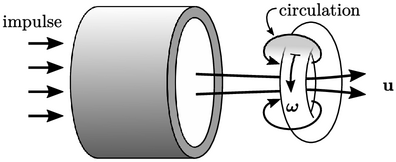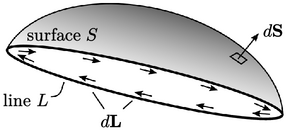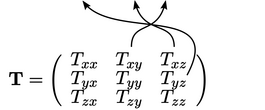2.11 Vorticity
Vorticity describes the tendency for a fluid to rotate locally, defined as
 |
(2.37) |
 operator is the curl
derivative.
The curl of a vector
operator is the curl
derivative.
The curl of a vector  is evaluated in Cartesian co-ordinates by
is evaluated in Cartesian co-ordinates by
 |
(2.38) |
Vorticity is difficult to picture under shear because the deformation masks the local rotation. By separating the deformation, as in the figure in Sec. 2.10 , the local rotation is revealed.

Vorticity  is often demonstrated
by a vortex ring produced by an air “cannon”
with smoke to visualise the flow. It reveals flow circulation around sections of the
torus, from front to back. The vorticity vectors are normal to the
planes of circulation, along the axis of the torus.
is often demonstrated
by a vortex ring produced by an air “cannon”
with smoke to visualise the flow. It reveals flow circulation around sections of the
torus, from front to back. The vorticity vectors are normal to the
planes of circulation, along the axis of the torus.

Stokes’s theorem8 relates circulation — the integral of
 around a closed curved line,
around a closed curved line,  — to the integral of
vorticity
— to the integral of
vorticity  over a section of surface
over a section of surface  bounded by the curve,
according to:
bounded by the curve,
according to:
![Z Z Z [dS (r u)] = (dS !) = (dL u): S S L \relax \special {t4ht=](img/index550x.png) |
(2.39) |
 is a vector
representing a segment of the line
is a vector
representing a segment of the line  . As you stand on
. As you stand on
 looking in the direction
looking in the direction  , with your head in the direction
, with your head in the direction
 ,
,
 is
oriented to your left.
is
oriented to your left.
Vorticity is related to the spin tensor
 in
Eq. (2.33
) by
in
Eq. (2.33
) by  , where
, where  is the Hodge
dual operator which extracts components of a vector from a tensor
is the Hodge
dual operator which extracts components of a vector from a tensor
 as
shown below:
as
shown below:
 |
(2.40) |


